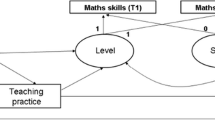Abstract
The teaching strategies teachers use in the classroom and in teaching the children with learning problems, with special reference to mathematics instruction and the criteria for identifying children with learning problems were explored. For this purpose a sample of 12 schools in Mumbai was used. Ten children from Grade IV were identified from each school, five with learning problems (teacher identified) and five without problems (randomly selected from the attendance register). Observations through videotaping the teacher’s interactions with children especially with those the teacher identified as having learning problems were done. The learning problems were also checked with the help of Behavioral Checklist for Screening Learning Disabilities and Diagnostic Test for Learning Disabilities and interview of teachers. Results indicated that that both the tests as well as teachers emerged as fair predictors of the problem. The implications of the findings for teacher training needs with reference to handling learning problems in the classroom have been drawn.
Similar content being viewed by others
References
Amidon, E.J. and Flanders, N.A. (Ed.) (1971). The role of the teacher in the classroom. Mineapolis: Association for productive teaching.
Anghileri, Julia. (2001). Contrasting approaches that challenge tradition. In Anghileri, J. (Ed.) Principles and practices in arithmetic teaching: Innovative approaches for the primary classroom. Buckingham. Philadelphia: Open University Press.
Anghileri, Julia. (2001). Intuitive approaches, mental strategies and standard algorithms. In Anghileri, J. (Ed.) Principles and practices in arithmetic teaching: Innovative approaches for the primary classroom. Buckingham. Philadelphia: Open University Press.
Bender, William, N. (1998). Learning disabilities: Characteristics identification and teaching strategies. Third Edition. Boston: Allan and Bacon.
Campbell Whatley Gloria D. (April, 2000). Disability in learning or just plain lazy?
Casas, A.M. and Castellar, R.G. (2004). Mathematics education and Learning Disabilities in Spain. Journal of Learning Disabilities, 37(1), 62–73.
Census of India, (2001). Age-group wise population http://www.indiastat.com/india/showdata.asp?secid=409341 & ptid=409340&level=4
Committee for Review of National Policy on Education (1990). Towards an enlightened and humane society: NPE, 1986 — A review. (Ramamurti Committee Report). New Delhi: Author.
Cornoldi, Cesare and Lucangeli, Daniela. (2004). Arithmetic education and learning disabilities in Italy. Journal of Learning Disabilities, 37(1), 42–49.
Demetriou, H. and Wilson, E. (2008). Synthesising affect and cognition in teaching and learning. Social Psychology of Education, online first.
Enzensberger, Hans, M. (1998). Number Devil. Metropolitan Books.
Fey, J. (1969). Classroom teaching of mathematics. Review of Educational Research, 39(4), 535–551.
Geary, D.C. (2004). Mathematics and learning disabilities. Journal of Learning Disabilities, 37(1), 4–15.
Kapur, (2008). Profiles of academic skills deficits in Indian schools. In, K. Thapa, G.M. Van Der Aalsvoort and J. Pandey (Eds). Perspectives on learning disabilities in India: Current Practices And Prospects. New Delhi: Sage.
Kapur, M. (1995). Mental health of Indian children. New Delhi: Sage.
Konantambigi, Rajani M. and Shetty, Mamatha. (2008). Teacher identification of learning problems: Comparison with a screening device and learning disabilities test. In, K. Thapa, G.M. Van Der Aalsvoort and J. Pandey (Eds). Perspectives on Learning Disabilities in India: Current practices and prospects. New Delhi: Sage.
Konantambigi, R.M. (2003). Teacher assessment of teaching learning problems as manifestedby children in the normal classroom. Unpublished study, Tata Institute of Social Sciences, Mumbai.
Konantambigi, R.M. (2000). Home-School Transition: Adjustment and Performance of School Children. Unpublished study, Tata Institute of Social Sciences, Mumbai.
Kirshner, D. (2002). Untangling teachers’ diverse aspirations for student learning: a crossdisciplinary strategy for relating psychological theory to pedagogical practice. Journal of Research in Mathematics Education, 33(1), 46–58.
National Council of Educational Research and Training, (2005). National Curriculum Framework — 2005. New Delhi: Author.
Peterson, P.L., Fennema, E., Carenter, T.P. and Loef, M. (1989). Teachers’ pedagogical content beliefs in mathematics. Cognition and Instruction, 6(1), 1–40.
Sarangpani, P.M. (2005). Constructing school knowledge: An ethnography of learning in an Indian village. New Delhi: Sage Publications.
Selikowitz, M. (1998). Dyslexia and other learning difficulties-the facts (2nd ed.). Oxford: Oxford University Press.
Skott, J. (2004). The forced autonomy of mathematics teachers. Educational Studies in Mathematics, 55(1/3), 227–257.
Sowell, Evelyn J. (1989). Effects of manipulative materials in mathematics instruction. Journal for Research in Math Education, 20(5), 494–505.
Strauss, A. and Corbin, J. (1990). Basics of qualitative research: Grounded theory procedures and techniques. Sage Publications.
UNICEF and Amravati Zilla Parishad, Primary Education Division, Maharashtra, (1997). Ananddayee Prakalap (Amravati): Amravati Zillyatil Ananddayee Prathamik Shikshan. Mumbai: Authors
Verma, Preeti. (2008). Learning disabilities: Challenges in assessment and diagnosis. In, K. Thapa, G.M. Van Der Aalsvoort and J. Pandey (Eds). Perspectives on Learning Disabilities In India: Current Practices And Prospects. New Delhi: Sage.
Wood, Terry, Kobb, Paul and Yackel, Erna. (1991). Change in teaching mathematics: A case study. American Educational Research Journal, 28(3), 587–616.
Yackel, Erna (2001). Perspectives on arithmetic from classroom-based research in the United States of America. In Julia Anghileri (Ed.) Principles and practices in arithmetic teaching: Innovative approaches for the primary classroom. Buckingham. Philadelphia: Open University Press.
Zigmond Naomi, (1993). Learning Disabilities from An Educational Perspective. In G.R. Lyon, D. B. Gray., J.F. Kavanaugh, and N.A. Krasnegor (Eds.). Better Understanding Learning Disabilities: New Views from Research and Their Implications or Education and Public Policies. Baltimore: Paul Brooks Publishing Co.; pp. 251–272.
Author information
Authors and Affiliations
Corresponding author
Rights and permissions
About this article
Cite this article
Konantambigi, R.M., Nandini, R. Teaching strategies in mathematics for children in the normal classrooms: A qualitative analysis. Psychol Stud 54, 226–237 (2009). https://doi.org/10.1007/s12646-009-0029-y
Received:
Accepted:
Published:
Issue Date:
DOI: https://doi.org/10.1007/s12646-009-0029-y




